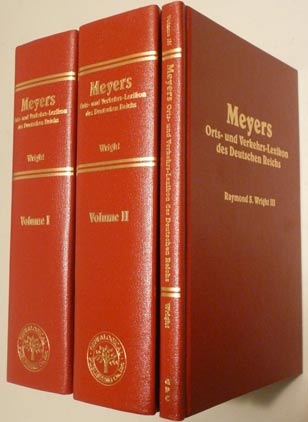
|
|
|
| Product Information: | ||
| Details: | OUT OF PRINT! DO NOT ORDER! Meyers Orts- und Verkehrs-Lexikon des Deutschen Reichs - With Researcher's Guide and Translations of the Introduction, Instruction for the Use of the Gazetteer, and Abbreviations. Three Volumes; by Raymond S. Wright III; Published 1912-13, Reprinted with the additional third volume in 2000; 2500 pp with numerous folding maps and full-page maps; Hard Cover, ISBN: 9780806316314; Item # GPC6504 Background Almost all serious German research begins with Meyers Orts- und Verkehrs-Lexikon, the massive gazetteer that describes approximately 210,000 cities, towns, hamlets, and dwelling places in the German Empire prior to World War I. It is an essential tool for locating information about every inhabited place in the former Empire, be it an independent community such as a city, village, market, estate, or hamlet, or a place with a few inhabitants belonging to another community. The millions of facts presented about these localities represent an entire library of reference works and enable the researcher to determine the whereabouts of civil, religious, court, and military records. The Reprint To use Meyers effectively, readers must understand its purpose, be able to interpret the gothic font in which it is printed, and grasp how the information contained in locality entries will guide researchers to records in today's archives, record offices, and libraries. Accordingly, this reprint of the last great edition of 1912-1913, in German, contains a new "Researcher's Guide" and translations of the original Introduction and Instruction for the Use of the Gazetteer by Professor Raymond S. Wright of Brigham Young University, rendering the great Meyers Orts- und Verkehrs-Lexikon accessible to the average researcher. In addition, this reprint edition includes a third volume consisting of the often-omitted Appendix to Volume II and the scarce Supplement of September 1913. Thus a rare and indispensable work, encompassing thousands of pages and dozens of maps--previously found in only a handful of American libraries--is not only available to researchers but is now a practical research tool. Contents Throughout this vast work locality entries are arranged alphabetically and describe each place in terms of the type of community it is (city, village, hamlet, etc.) and the civil, court, military, and religious jurisdictions under which it falls. An understanding of these several jurisdictions will assist researchers in their efforts to find original records that are housed today in church or government offices and archives. In the old German Empire three levels of government existed: national, state, and local. In Meyers, civil registration districts, court districts, and military districts are the national jurisdictions most often noted in the locality entries. Most of the other entries described in the entries are state and local. In the past, each of these levels of government maintained their own archives, and this support continues today. All three levels of government have preserved records that will interest historians and genealogists. Records created by all levels of state government in the former Empire, including records of provinces and districts, are normally preserved in the state archives of the present-day German state whose boundaries encompass the historic state or province. Records of cities and towns, such as citizen's lists, tax lists, and property lists, are maintained in local archives, although in some cases they have been transferred to the nearest state archive. More localized yet, records of birth, marriage, and death from 1876, when mandatory civil registration became law, are sometimes found in local city or town halls, while records of even smaller jurisdictions--villages, hamlets, etc.--can often be found in nearby civil registration offices. Religious records, in particular records of baptism, confirmation, marriage, and burial, are found in the various parish jurisdictions noted in the work. The parish continues to be the basic unit of church government for Germany's dominant religions--Evangelical Lutheran and Roman Catholic--and most of their records remain in the custody of local churches or in larger ecclesiastical archives. Many of these parish records have been microfilmed by the LDS Church and are available at the Family History Library in Salt Lake City or in Family History Centers throughout the country. Much the same is true of court records and military records, the former containing details of probates, school records, records of births, marriages, and deaths, and civil suits; the latter containing important personal information about an individual: name, birth date, birthplace, marriage date and place, spouses's name, names of dependents, and service record. Again, using the locality tools provided by this gazetteer, the researcher can quickly determine if the records are held on microfilm/microfiche by the LDS Church. In Brief Summing up the merits of this monumental work, we can safely say that it is the best tool available to help genealogists identify the agencies and jurisdictions that created records about people who lived in Germany. Because the locality entries describe the government, court, religious, and military jurisdictions of Germany, researchers can use this information to identify the location of each community's records in modern archives or government offices. The same information helps researchers determine whether original records are available on microfilm or microfiche at the Family History Library and at LDS Family History Centers worldwide. |
|

